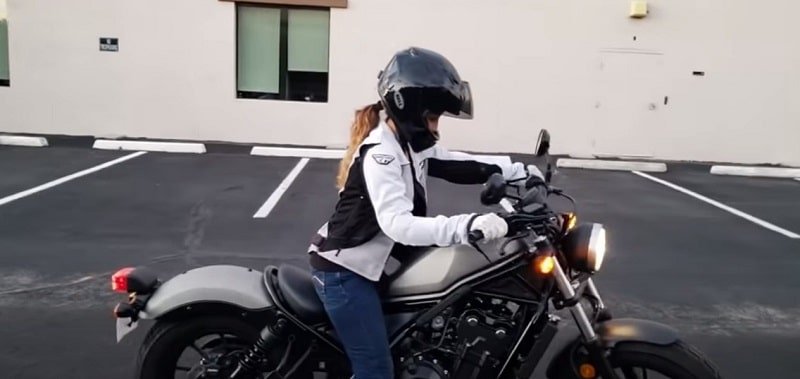Deprecated: mb_convert_encoding(): Handling HTML entities via mbstring is deprecated; use htmlspecialchars, htmlentities, or mb_encode_numericentity/mb_decode_numericentity instead in /home/u598013642/domains/motorcyclegear101.com/public_html/wp-content/themes/acabado/functions.php on line 2160
Deprecated: mb_convert_encoding(): Handling HTML entities via mbstring is deprecated; use htmlspecialchars, htmlentities, or mb_encode_numericentity/mb_decode_numericentity instead in /home/u598013642/domains/motorcyclegear101.com/public_html/wp-content/themes/acabado/functions.php on line 2160
There are lots of different motorcycles on the market today, from cruisers to dirt bikes. There is one thing they all have in common, they all are all different sizes and weights.
You don’t need to be a weightlifter to ride a motorcycle, but you need enough physical strength to handle your motorcycle. When the bike is on the move, little upper body strength is required; you need to be calm, in control, and aware of other road users. You also need the mental strength to ride securely and safely.
Unfortunately, many people are apprehensive about riding a motorcycle because they don’t think they have enough strength, but anybody of any size can take it up. This article will expand more on what you get the hang of as a first-time motorcyclist.
Is It Hard To Hold Up A Motorbike?
This concern is understandable, most motorbikes look powerful, and it’s natural to think that you need to be exceptionally strong to hold it up. Cruiser bikes can be quite heavy, and you may need to be quite strong to handle one. However, most sporty bikes take little effort to handle. Some little upper-body strength can help, but you don’t need to be athletic. There are three occasions when the weight of the bike can be an issue:
1. SLOW-SPEED MANEUVRES
If you are trying to turn at a slow speed, like five mph, you will feel the bike’s weight more, but knowing what to do with the clutch is more critical in this situation than being physically fit. However, you need to understand how to use the strength you have more than any other point in motorcycle riding. To get out of a cramped parking area, be sure to have a foot ready to put down when necessary.
2. MOVING WITHOUT POWER
Motorbikes are bulky, heavy, and large machines; even the average street bike weighs about 300 pounds. Be aware that there will be times when you could get stuck moving that weight about. For example, if the battery died, you would need to roll your bike to build enough momentum for the engine to turn. This could be difficult if you are on a level surface rather than at the top of a hill. Another scenario is if you need to put your bike on a trailer and can’t get it up a ramp. You may need people to help you; this can happen to the strongest motorcyclists.
3. WHEN THE BIKE FALLS OVER
This is a frightful situation to be in with your bike, but it happens even to the most experienced motorcyclists. Some people can pick up their bikes themselves while others need help. But you shouldn’t let this deter you from taking up motorcycling. It’s critical that you are at ease with your machine and that you grasp the proper way to ride; this means lots of practice.
Is Learning To Ride A Motorbike Hard?
Learning to ride a motorbike is easier than most people believe. They are not very complicated machines requiring expert skill levels to get started; really, all they are, are bicycles with engines. If you can pedal a bicycle, you can easily transition to a motorcycle. Balance is fundamental to motorcycle riding, much like bicycles. Then you must learn to control the speed and change the gears, turning, and braking. If you’ve never cycled before, mastering the balance doesn’t take very long.
How long it takes you to learn motorcycle riding is up to you as everyone progresses at different rates, some people can learn it in one day while others need several weeks. Take your time with the learning process and examine the following steps to help you get riding:
1. GEARING UP
Riding a motorbike comes with risks. But to minimize them, it’s essential to wear the right gear to protect yourself in the event of a crash. You must wear gloves, a helmet, durable boots (covering your ankles), a motorcycle jacket, and pants. If you’re not certain what kind of riding you plan to do mostly, street, on-road, off-road, adventure, etc., it’s best to stick to basics like Dynaeema or Kevlar.
2. CHOOSING YOUR MOTORCYCLE
Do not be too concerned about the model or make of your bike, but instead pay attention to the power ratio and weight. As a beginner, you need a light bike somewhere in the range of 250-650 cc, but you can move to bigger and more powerful machines as your riding abilities improve.

With that said, there is no particular motorbike for beginners – anyone can be a good first bike. However, you will know which one is right for you when you sit on it and get a feel for it. You need to feel balanced, and you should feel comfortable putting both feet down on the ground. Ask yourself, can you get on and off with ease? Can you hold it on the side stand? Are you happy with your seating position?
Once you have sat on the bike, move it back and forth. Put the motorcycle on the center stand and move it around a bit. You must be sure that you can easily handle the motorcycle whether you are in or off the saddle.
3. BRAKING
Before you begin moving your motorcycle, you must understand how to brake properly. The rear brake is the pedal to your right, and the front brake is the lever on the right handlebar.
- To slow down your bike or make a complete stop, use both brakes simultaneously. Make sure to apply the rear brake by stepping on it and press the front brake lever gradually and steadily.
- Do not stamp down hard on the brakes, as the wheels could lock and put you off balance.
- Slowly push down the rear brake and pull the brake lever gradually to achieve controlled, smooth braking.
- Practice braking when the motorcycle is still standing, roll forward slightly and press down the rare brake.
- Repeat this step by pressing on the lever and engage the brakes without catching the wheel discs too quickly.
4. CLUTCH AND THROTTLE
Once you have mastered braking, it’s time to ride your motorcycle and get to grips with the controls. New riders are often nervous about shifting gears, but you will get the hang of it with practice. There are five gears on a motorbike, first is down, then neutral, all the way to the fifth gear.
You must select the gears by bringing the clutch lever in. To get going with the bike, press on the clutch lever, then put it in first gear. Slowly roll the throttle while releasing the clutch, as you would with a car. When the bike is in motion, slowly release the clutch and add a bit of throttle. When you are at higher RPMs, take in the clutch lever fully, and accelerate less, before engaging second gear. For slowing down the bike, move the gears down to first gear and put it in neutral when you have stopped. Keep doing this until you have mastered gear shifting.
5. TURNING
Once you get used to the controls and feel confident, you can move on to turning the bike. You have to contend with U-turns, corners, and all sorts of tight spaces. When you turn corners, your bike will naturally incline into the corner. Go with that movement instead of just relying on your handlebars. Maintain a steadied throttle and look where you are going. Look through the corner to help you stay balanced. This will help you to avoid a crash or to stall.
6. KEEP PRACTICING
When you have finished a motorcycle course and obtained your license, you are ready to ride. Of course, as a beginner, you need all the practice you can get. However, start slow, practice riding quiet roads, and be mindful of traffic safety before hitting highways and interstates. As you get more used to riding, the controls will become second nature to you. Just remember to start slowly, refine your abilities, and, more importantly, relax.
Final Thoughts
As you can see, riding a motorcycle is more about balance and road safety awareness and has little to do with physical strength. As a beginner, you must think about how to navigate your bike safely. It may help you to take a course with the MSF. There you will learn the fundamentals from an experienced instructor in a controlled and safe environment.
When you are new, do not bite off more than you can chew, and just because riding a motorcycle doesn’t require brute strength, you still have to use the power you have to control the bike. Make sure you feel completely comfortable with your bike and that you can balance it easily. Understand your limitations, and get more practice should you need it.
Table Of Content

